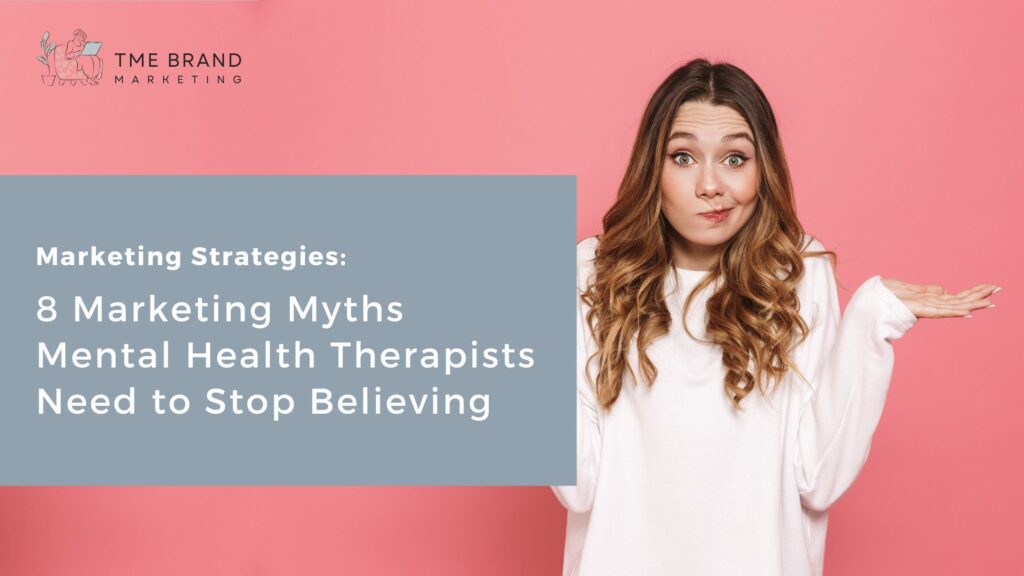
8 Marketing Myths Mental Health Therapists Need to Stop Believing
When it comes to marketing for mental health therapists, the biggest obstacles often aren’t a lack of effort—they’re the myths that lead you down the wrong path.
As the founder of TME Brand Marketing (Hey there, I’m Jennifer!), I’ve had the privilege of working with countless therapists who are navigating the often overwhelming world of online marketing.
In my experience, there are a lot of misconceptions about what it takes to build a successful online presence, especially for mental health professionals.
Many therapists invest time and resources into strategies that don’t deliver the results they expect, all because they’ve fallen into some common marketing myths. To help you avoid these pitfalls, I’m breaking down some of the biggest misconceptions I’ve seen—and what you can do instead to ensure your practice thrives online.
Myth #1: “I have a website, so I’m set.”
As I’ve worked with therapists looking to expand their online presence, one of the most common misconceptions I encounter is the belief that simply having a website is enough to drive growth. Don’t get me wrong—having a website is a crucial first step, but it’s exactly that: a first step.
Your website is essentially your digital business card, but without strategies like Search Engine Optimization (SEO), social media marketing, and content creation, it’s unlikely that the right people are going to find it. The goal isn’t just to have a website but to ensure it’s attracting the right audience. To really see your practice grow, you need to engage in a holistic digital marketing strategy that includes driving traffic from various sources and converting that traffic into clients.
Summary: Optimize your website for SEO and create multiple methods of sending traffic to your website to improve Google ranking.
Myth #2: “Social media will bring all the clients I need.”
There’s no magic formula for going viral on social media—anyone who tells you otherwise is scamming you. Building a strong social media presence isn’t about overnight success; it’s about consistency and strategy. At TME Brand Marketing, we find that the best way to grow your following is by posting video content at least twice a week, targeting a specific niche, and using cross-promotion tags, geotags, and hashtags that are relevant to your audience. For example, if you’re an EMDR therapist working with Gen Z women dealing with trauma, your content should consistently speak to that group’s unique needs.
However, social media growth is a long game. Simply relying on platforms like Instagram, Pinterest, YouTube, or TikTok won’t bring in all your clients. These large search engines can help you get found, but they need to be part of a broader, quantifiable marketing strategy. This includes email marketing, blog writing, and creating lead-generating freebies like e-books or guides. When you get all these sources working together, that’s when you’ll see real results. Social media is just one piece of the puzzle—make sure it’s paired with other efforts to maximize your reach and effectiveness.
Summary: Identify your niche on social media. Determine your voice and branding. Create content that engages with your niche, create content that sends users to your website, and create content that gets people signed up for your email list.
Myth #3: “More traffic means more clients.”
A lot of therapists believe that the more traffic they can get to their website, the more clients they’ll end up with. Unfortunately, it’s not that simple. More traffic doesn’t necessarily translate into more clients; what really matters is the quality of the traffic you’re getting.
You want to attract visitors who are actually interested in your services and who align with the type of clients you want to work with. This is where SEO, targeted content, and meaningful engagement come into play. It’s far better to have fewer visitors who are a great fit for your practice than tons of visitors who are just browsing and not likely to book a session.
Summary: Sending traffic to your website is the best way to jumpstart your Google ranking. Optimize your website and social media with content specific for your audience to ensure the quality of visitors.
Local to Nashville? Join us for our Live Seminar on October 23rd.
Cut Through The Noise: The Essential Marketing Strategies You Actually Need to Build Your Practice's Online Presence.
Feel like you’re drowning in advice on how to market your business? Join our laid-back, no-BS seminar where we’ll break down the strategies that truly matter and help you focus on what actually works.
Myth #4: “Once I’ve optimized my site for SEO, I’m done.”
SEO isn’t something you can set and forget. Many therapists think that once they’ve optimized their website for search engines, they can check that box and move on. But SEO is an ongoing process, not a one-time task.
Search algorithms change regularly, and you need to adapt your content and keywords accordingly to maintain your visibility. Additionally, as your practice evolves, your website should too. Keeping your content fresh and relevant is key to staying competitive and continuing to attract new clients.
Summary: Keeping your website design up-to-date and your content fresh is the best SEO strategy. This is why we suggest maintaining a blog for “fresh” content and sending these articles out to your email list to send people to your website for the traffic boost.
Myth #5: “Posting any content consistently will help.”
I’ve seen therapists fall into the trap of thinking that posting any content on a regular schedule will help them grow their online presence. While consistency is important, quality matters just as much. Your content should speak directly to your clients’ concerns, answering their questions and addressing their pain points.
The goal isn’t just to fill up your blog or social media with random posts but to provide value that resonates with your audience. This builds trust and positions you as an expert in your field. Posting for the sake of posting won’t get you anywhere—meaningful, strategic content will.
Summary: Be mindful and create a strategy for what you post online. Don’t just post to post. Maintain consistency in your voice, content, and schedule of posting. Set aside time each month to plan it out.
Myth #6: “Every therapist needs an app.”
There’s a lot of buzz around mobile apps, and some therapists might feel pressured to develop one for their practice. But the reality is, not every practice needs an app. A well-designed, mobile-responsive website is often more than enough to engage clients and make it easy for them to schedule appointments.
Apps are costly and require ongoing maintenance. In most cases, a user-friendly website can do everything an app can, without the extra investment. Don’t feel like you have to jump on the app bandwagon unless it truly adds value for your clients.
Summary: Unless you are working with a coaching side of your business, an app is a lot of work to maintain and a huge educational campaign for your clients. Use existing tools coupled with your website to streamline your business for your clients.
Myth #7: “Reviews don’t really matter for therapists.”
We know it’s unethical to ask clients for reviews directly, which can make it tricky to gather feedback. But don’t worry—there are still ethical ways to highlight your reputation. In fact, reviews are crucial.
So, how can therapists ethically add reviews to their websites? Utilize trustworthy platforms like Health Grades, Psychology Today, and your Google Business profile to collect reviews. While you can’t directly ask your clients to leave reviews, you can still let them know about these platforms by mentioning it in a subtle way on your website or in your practice. For example, simply noting, “You can find us on Google Business or Psychology Today” makes it easy for clients to leave a review if they choose to, without feeling pressured.
Once you’ve gathered a few great reviews, copy your best ones and scatter them throughout your website. Feature them on your homepage, services pages, or even your bio to demonstrate your credibility. You can also encourage referrals from satisfied clients or showcase testimonials from colleagues, supervisors, or other professionals who can vouch for your expertise.
Respond to feedback, whether positive or negative, with a general thank you, without mentioning specific details about their therapy to maintain confidentiality. If a negative review pops up, it’s best to address concerns privately if appropriate. Taking these steps will ensure that your online presence remains professional, ethical, and trustworthy.
Summary: Managing your online reputation is just as important as getting reviews. Many potential clients read testimonials before choosing a therapist, so having positive reviews on your site can make a huge difference in building trust and credibility.
Myth #8: “I can just build my website myself.”
With DIY website builders like Wix or Squarespace, it’s tempting to try to save some money and create your own website. However, professionally designed websites often outperform DIY sites in terms of SEO, user experience, and overall functionality.
As a therapist, your time is better spent focusing on your clients, not troubleshooting website issues or learning the ins and outs of web design. A professionally built website will help you stand out from the crowd and attract more of the clients you want to work with.
Summary: Yes! You totally can build your website on your own, but keep in mind that the design needs to be modern, content needs a good readability score for Google, your site needs to be optimized for Google, and your website needs to connect to all your platforms. Feel free to reach out at any time if you need help.

